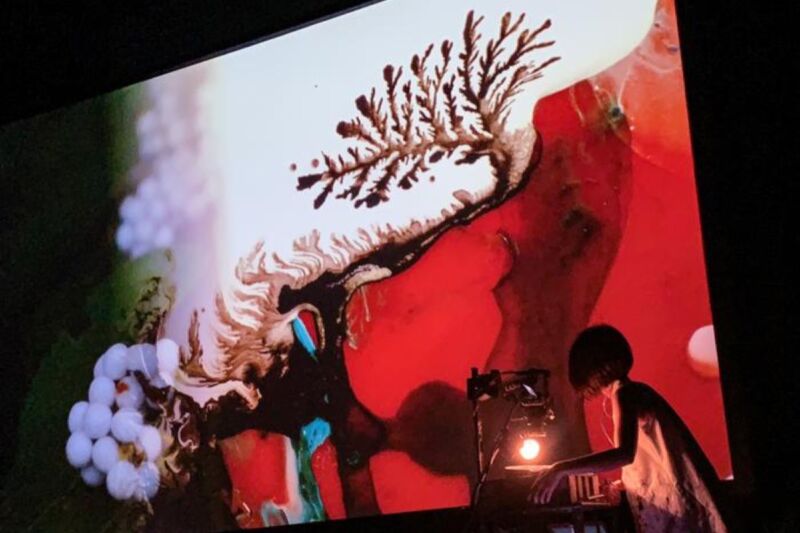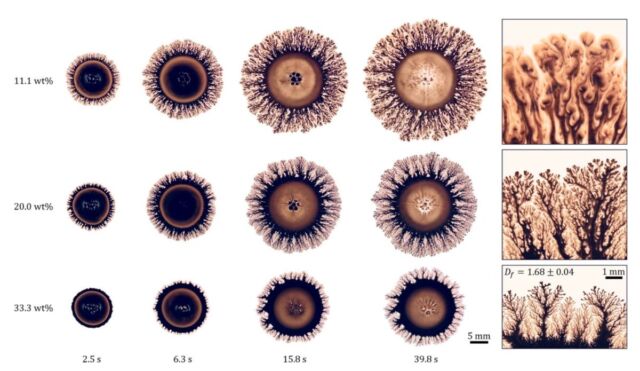
Dendritic painting is an artistic technique that involves depositing mixtures of ink and rubbing alcohol onto paint spread on a substrate, producing branching, tree-like patterns. Two physicists have now analyzed the underlying fluid dynamics at work to create those intricate shapes and patterns, describing their findings in a new paper published in the Proceedings of the National Academy of Sciences Nexus.
“Painters have often employed fluid mechanics to craft unique compositions,” said co-author Eliot Fried of the Okinawa Institute of Science and Technology (OIST) in Japan. “We have seen it with [Mexican muralist] David Alfaro Siqueiros, Jackson Pollock, and Naoko Tosa, just to name a few. In our laboratory, we reproduce and study artistic techniques, to understand how the characteristics of the fluids influence the final outcome.”
Fried is one of several scientists intrigued by how artists exploit fluid dynamics in their work. For instance, Roberto Zenit, a physicist at the National Autonomous University of Mexico, has been studying the physics of fluids at work in those techniques for several years, concluding that the artists were “intuitive physicists,” using science to create timeless art—including Siqueiros’ “accidental painting” technique.
The technique involves pouring layers of paint on a horizontal surface and letting whorls, blobs, and other shapes form over time, essentially placing a dense fluid on top of a lighter one. This creates a classic instability because the heavier liquid will push through the lighter one. Zelnit has also studied the “decalcomania technique” favored by such artists as Max Ernst, Oscar Dominguez, and Remedios Varo, which involves painting a surface and covering it with a flexible sheet of plastic, before ripping off the plastic, forming tree-like structures.

Okinawa Institute of Science and Technology
As for Pollock, early on he employed a “flying filament” or “flying catenary” technique before he perfected his dripping methods. The paint forms various viscous filaments that are thrown against a vertical canvas. The dripping technique involved laying a canvas flat on the floor and then pouring paint on top of it. Sometimes, he poured it directly from a can; sometimes he used a stick, knife, or brush; and sometimes he used a syringe. The artist usually “rhythmically” moved around the canvas as he worked. His style has long fascinated physicists, as evidenced by the controversy surrounding the question of whether or not Pollock’s paintings show evidence of fractal patterns.
In 2011, physicists examined Pollock’s use of a “coiling instability” in his paintings, mathematically describing how a viscous fluid folds onto itself like a coiling rope—just like pouring cold maple syrup on pancakes. A 2019 study found that the vast majority of Pollock’s traces were produced because the artist actively avoided coiling instabilities. And in 2023, researchers used reinforcement learning to exploit rather than suppress coiling instabilities, applying this method to direct ink writing, a versatile means of 3D and 4D printing. They even decorated a cookie with chocolate syrup to demonstrate the viability of their new approach.
Fried and co-author San To Chan, also at OIST, were inspired by this prior work, as well as contemporary artists like Tosa—known for exciting paint with sound waves and capturing how it moves on high-speed video—and Akiko Nakayama. Nakayama works with multicolored inks mixed with rubbing alcohol to create dendritic paintings in real time, exploiting the underlying fluid dynamics to create unique shapes and textures. “Dendritic painting poses an interesting yet nontrivial problem involving the evaporation, propagation, and pattern formation of thin liquid films atop rheologically complex media,” the authors wrote.

